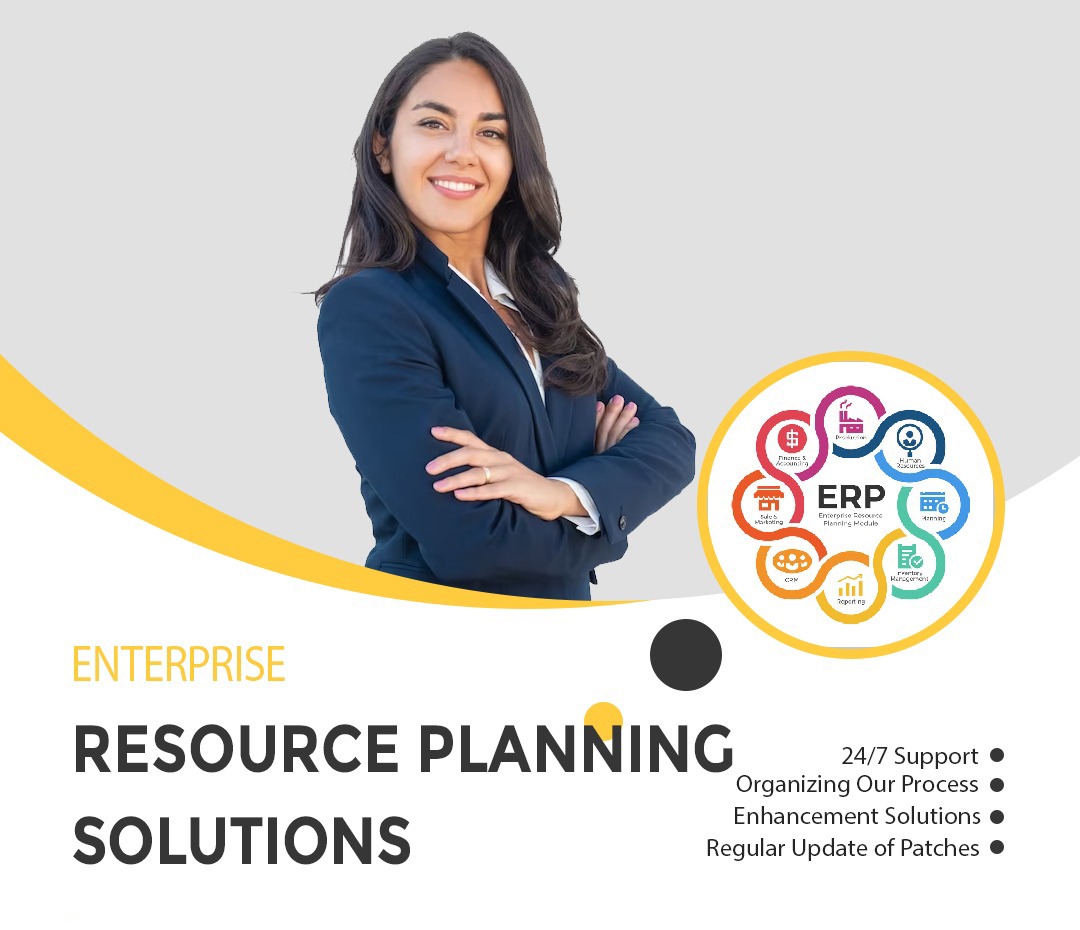ERP Software Implementation and Tips for Reducing Prices
Introduction of ERP Software
ERP (Enterprise Resource Planning) software is a type of software system that is designed to manage and integrate various business operations, such as accounting, human resources, inventory, customer relationship management, and supply chain management, into a single system. The purpose of an ERP system is to streamline business processes, increase efficiency, and provide real-time visibility into various aspects of a business.
ERP software typically includes a centralized database that stores all the data related to a business’s various functions. This allows for easy access to information and enables different departments to share data and communicate with each other seamlessly. Additionally, ERP systems often provide tools for data analysis and reporting, which can help businesses make informed decisions based on real-time data.
ERP software is used by a wide range of businesses, from small startups to large corporations. It can be customized to meet the specific needs of a business and can be deployed on-premises or in the cloud. While ERP systems can be complex and require significant time and resources to implement, they can provide significant benefits to businesses that use them effectively.
What is the ERP Software Price?
The price of ERP software can vary greatly depending on a variety of factors, such as the size and complexity of the business, the specific modules and features required, and the deployment model (cloud-based vs. on-premises).
Some ERP software vendors offer pricing models based on the number of users, while others offer subscription-based pricing that includes ongoing support and upgrades. Some vendors may also charge additional fees for implementation, customization, and training.
It is important to note that ERP software is often a significant investment for businesses, and it is essential to consider the total cost of ownership, including ongoing maintenance and support costs. Additionally, it is important to evaluate the potential return on investment and the impact on business processes and workflows before making a purchasing decision.
What does ERP implementation cost in India?
The cost of ERP implementation in India can vary greatly depending on several factors, including the size of the organization. The scope of the implementation, the specific ERP software being used, and the level of customization required.
In general, the cost of ERP implementation in India for small and medium-sized enterprises (SMEs) can range from INR 5 lakhs to INR 25 lakhs (approximately USD 7,000 to USD 35,000), while larger organizations may spend upwards of INR 1 crore (approximately USD 140,000) or more on implementation.
It is important to note that the cost of implementation is only one aspect of the total cost of ownership of an ERP system. Ongoing maintenance, support, and upgrades can add significantly to the overall cost over time.
To accurately determine the cost of ERP implementation in India for your organization, it is recommended to conduct a detailed analysis of your requirements, evaluate various ERP vendors and their pricing models, and work closely with a trusted ERP implementation partner to develop a comprehensive implementation plan and budget.
Factors that may impact future ERP pricing models?
Several factors could impact future ERP pricing models, including:
1. Cloud adoption:
As more organizations move their operations to the cloud. ERP vendors may shift towards subscription-based pricing models that include ongoing support and upgrades.
2. Industry-specific functionality:
ERP systems are increasingly being tailored to meet the specific needs of different industries, such as healthcare, manufacturing, or retail.
3. Artificial intelligence and automation:
As AI and automation become more prevalent in ERP systems, vendors may offer pricing models that reflect the added value of these features. Such as reducing the need for manual data entry or providing more accurate forecasting and analysis.
4. Integration with other systems:
As organizations increasingly rely on multiple software systems to manage different aspects of their operations. ERP vendors may offer pricing models that reflect the level of integration required with other software systems.
5. Customization:
ERP systems are often customized to meet the unique needs of each organization, and this customization can impact pricing models. Vendors may offer pricing models that are tailored to the level of customization required. Such as charging more for extensive customization or offering pre-built templates for quicker implementation.
Tips for reducing the cost of implementing an ERP system
Implementing an ERP system can be a significant investment for any organization, and it is essential to manage costs and minimize expenses wherever possible. Here are some tips for reducing the cost of implementing an ERP system:
1. Define your requirements clearly:
Before beginning the implementation process, it is essential to define your requirements clearly and determine the specific modules and features that your organization needs. This will help you avoid unnecessary expenses and ensure that the system meets your business needs.
2. Choose the right vendor:
Conduct thorough research and evaluate different vendors to find one that offers the features you need at a reasonable price. It is also important to consider the vendor’s reputation, track record, and level of support.
3. Consider cloud-based deployment:
Cloud-based ERP systems typically have lower upfront costs and require less investment in hardware and IT infrastructure. They may also offer more flexibility in terms of scalability and customization.
4. Avoid excessive customization:
While customization may be necessary to meet your organization’s unique needs. Excessive customization can add significantly to the cost and complexity of the implementation process. It is important to strike a balance between customization and the cost and time required to implement it.
5. Conduct thorough testing:
Testing the system thoroughly before going live can help identify and fix any issues before they become more costly to address later on. This can help prevent the need for additional development and customization.
6. Provide comprehensive training:
Comprehensive training for end-users can help ensure that the system is used effectively and can minimize the need for additional support and troubleshooting.
Why does Customer Support matter?
Customer support is a critical aspect of any business. As it plays a key role in building and maintaining relationships with customers. Here are some reasons why customer support matters:
1. Builds customer loyalty:
Providing excellent customer support can help build customer loyalty and encourage repeat business. When customers feel that their needs and concerns are being heard and addressed. They are more likely to continue doing business with the company.
2. Enhances the customer experience:
Good customer support can enhance the overall customer experience by providing prompt and effective assistance when needed. This can help create a positive impression of the company and increase customer satisfaction.
3. Resolves issues quickly:
When customers encounter issues with a product or service, they expect prompt and effective assistance. Providing good customer support can help resolve issues quickly, reducing the risk of negative feedback or reviews.
4. Improves brand reputation:
Good customer support can help improve a company’s brand reputation by showing that the company values its customers and is committed to providing excellent service.
5. Generates positive word-of-mouth:
Satisfied customers are more likely to recommend a company to others. Which can help generate positive word-of-mouth and attract new customers.
Conclusion
In conclusion, ERP software is an important tool for managing complex business processes and improving organizational efficiency. However, the cost of implementation can be significant, and it is important to manage costs and minimize expenses wherever possible. Choosing the right vendor, defining requirements clearly, and avoiding excessive customization are all important steps in reducing the cost of implementation. Additionally, providing good customer support is essential for building and maintaining strong customer relationships, enhancing the customer experience, and achieving business success. By focusing on these key areas, organizations can maximize the benefits of ERP software while minimizing the costs and risks associated with implementation.
How much does ERP software cost?
The cost of ERP software can vary widely depending on the specific features and capabilities needed, as well as the size and complexity of the organization implementing it. Prices can range from several thousand dollars to several million dollars.
Why is ERP costly?
ERP software can be costly because it is a comprehensive and complex system that integrates multiple business functions and processes. The cost can include software licensing fees, implementation, and customization costs, hardware and infrastructure expenses, ongoing maintenance and support, and training and consulting services. Additionally, ERP systems are typically designed to handle large volumes of data and users, which can require significant computing resources and infrastructure investments.
What is the average ERP cost in India?
The average cost of ERP software in India can vary widely depending on the specific requirements and scope of the project. However, small and medium-sized businesses can typically expect to pay anywhere from a few lakhs to a few crores of Indian rupees for ERP software, implementation, and ongoing support. The cost may be influenced by factors such as the number of users, the complexity of the business processes, the level of customization required, and the specific vendor or solution chosen.
Which ERP system is mostly used in business in India?
There are several ERP systems used by businesses in India, and the most popular ones vary depending on the industry and the size of the organization. However, some of the most commonly used ERP systems in India include SAP, Oracle E-Business Suite, Microsoft Dynamics, Tally ERP, and Zoho ERP. These systems offer a wide range of features and capabilities to support various business functions, such as finance, human resources, supply chain management, and customer relationship management.
What is the success rate of ERP?
The success rate of ERP implementations can vary widely depending on a variety of factors, such as the scope and complexity of the project, the level of user adoption, and the quality of the implementation process. Studies have shown that ERP success rates range from approximately 60% to 80%, with some implementations achieving higher success rates through careful planning, effective change management, and ongoing monitoring and improvement. However, there is no single guaranteed rate of success, and each implementation must be tailored to the specific needs and challenges of the organization.
Which industry uses ERP the most?
ERP systems are widely used across many industries, but some industries make more use of ERP systems than others. Manufacturing and distribution companies are among the industries that use ERP systems the most. This is because ERP systems can help manage the complex supply chains and production processes involved in these industries. Other industries that make extensive use of ERP systems include retail, healthcare, finance, and professional services. However, the specific industries that use ERP systems the most can vary depending on the region, size of the organization, and other factors.
What is the most expensive ERP system?
The cost of ERP systems can vary widely depending on the specific features and requirements of the organization. However, some of the most expensive ERP systems include SAP S/4HANA, Oracle ERP Cloud, and Microsoft Dynamics 365. The cost of these systems can range from several hundred thousand dollars to several million dollars, depending on factors such as the number of users, the level of customization, and the specific modules and features required. The cost may also include ongoing maintenance and support, training, and consulting services.
What are the two benefits of using ERP?
There are many benefits of using ERP systems, but two key benefits are:
- Increased Efficiency:
ERP systems help to automate and streamline business processes, reducing the need for manual data entry and other repetitive tasks. This can save time and improve accuracy, allowing employees to focus on more value-added activities.
- Improved Visibility:
ERP systems provide real-time data and insights into various aspects of the business, allowing decision-makers to make more informed and timely decisions. This can improve the overall performance of the organization, increase customer satisfaction, and drive growth and profitability.
What are the 3 common types of ERP?
The three common types of ERP systems are:
- On-premise ERP:
The ERP software is installed and runs on the organization’s servers and hardware, allowing for greater control and customization.
- Cloud-based ERP:
The ERP software is hosted on a remote server and accessed through the internet, providing greater flexibility and scalability.
- Hybrid ERP:
This combines elements of both on-premise and cloud-based ERP systems, allowing organizations to leverage the benefits of both approaches while addressing their unique needs and requirements.
Why is ERP so popular?
ERP systems are popular because they offer many benefits to organizations, such as:
- Increased efficiency and productivity through automation and streamlined processes
- Improved accuracy and data integrity
- Better visibility and control over business operations
- More effective decision-making through real-time data and insights
- Enhanced collaboration and communication across departments and locations
- Improved customer satisfaction through faster and more efficient service
- Increased agility and flexibility to adapt to changing business needs and market conditions.
Contact us for More Services, Which we Provide
7) Chat Service
10) Web Hosting
12) Video Designing
Contact Us
+91-9380797662
info@emazel.com
Author


